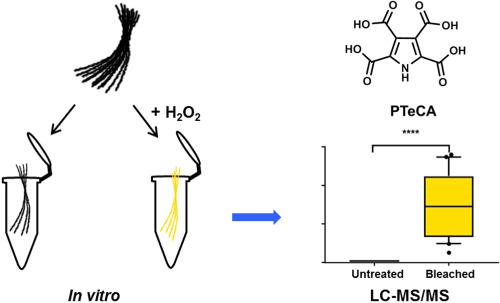当前位置:
X-MOL 学术
›
Drug Test. Anal.
›
论文详情
Our official English website, www.x-mol.net, welcomes your feedback! (Note: you will need to create a separate account there.)
A possible new oxidation marker for hair adulteration: Detection of PTeCA (1H-pyrrole-2,3,4,5-tetracarboxylic acid) in bleached hair.
Drug Testing and Analysis ( IF 2.9 ) Pub Date : 2019-12-27 , DOI: 10.1002/dta.2713 Lisa Eisenbeiss 1 , Tina M Binz 2 , Markus R Baumgartner 2 , Andrea E Steuer 1 , Thomas Kraemer 1
Drug Testing and Analysis ( IF 2.9 ) Pub Date : 2019-12-27 , DOI: 10.1002/dta.2713 Lisa Eisenbeiss 1 , Tina M Binz 2 , Markus R Baumgartner 2 , Andrea E Steuer 1 , Thomas Kraemer 1
Affiliation

|
Hair analysis has become a valuable tool in forensic toxicology to assess drug or alcohol abstinence. Yet, hair adulteration by cosmetic products presents a major challenge for forensic hair analysis. Oxidative treatments, e.g. bleaching, may lead to analyte loss and thereby to false negative results. Currently, the eumelanin degradation product 1H‐pyrrole‐2,3,5‐tricarboxylic acid (PTCA) serves as a marker for oxidative hair treatment, but requires the definition of cut‐off values. To investigate further eumelanin degradation products as markers for oxidative hair treatment, hair samples with and without in vitro bleaching (hydrogen peroxide (H2O2) concentrations 1.9% up to 12%; incubation times 15 min, 30 min, 60 min) were analyzed by liquid chromatography coupled to high‐resolution time of flight mass spectrometry (HPLC‐HRMS). The distribution of eumelanin degradation products along the hair shaft was investigated for routine applicability after segmentation of cosmetically untreated hair samples and authentically treated hair samples. The signals of the eumelanin degradation products PTCA, 1H‐pyrrole‐2,3,4‐tricarboxylic acid (isoPTCA), and 1H‐pyrrole‐2,3,4,5‐tetracarboxylic acid (PTeCA) were found to be significantly elevated after in vitro bleaching already with low H2O2 concentrations and after short incubation times. In contrast to PTCA and isoPTCA, PTeCA was not detectable in cosmetically untreated segments up to 12 cm from hair root and was only formed through the oxidation process. The results of the study show that the detection of PTeCA within the proximal 3 to 6 cm segment can be applied to reliably detect hair adulteration attempts through hair bleaching.
中文翻译:

一种可能的假发氧化新标记:漂白头发中PTeCA(1H-吡咯-2,3,4,5-四羧酸)的检测。
头发分析已成为法医毒理学评估毒品或酒精戒断的重要工具。然而,化妆品对头发的掺假对法医头发分析提出了重大挑战。氧化处理(例如漂白)可能会导致分析物丢失,从而导致假阴性结果。目前,金黄色素降解产物1H-吡咯-2,3,5-三羧酸(PTCA)可作为氧化性头发护理的标记,但需要定义临界值。要研究进一步的双美金降解产物作为氧化型头发的标记物,无论是否进行体外漂白(过氧化氢(H 2 O 2)浓度1.9%至12%; 液相色谱结合高分辨率飞行时间质谱(HPLC-HRMS)分析了15分钟,30分钟,60分钟的孵育时间。在对未经化妆品处理的头发样品和经真实处理的头发样品进行分割之后,研究了直链菊红素降解产物沿发干的分布,以了解其日常适用性。发现在经过以下处理后,木兰素降解产物PTCA,1H-吡咯-2,3,4-三羧酸(isoPTCA)和1H-吡咯-2,3,4,5-四羧酸(PTeCA)的信号显着升高低H 2 O 2的体外漂白浓度和较短的孵育时间后。与PTCA和isoPTCA相比,在距发根12 cm以内的未经美容处理的部分中未检测到PTeCA,而仅通过氧化过程形成。研究结果表明,在近端3至6厘米段内检测到PTeCA可以通过脱发可靠地检测出头发掺假的企图。
更新日期:2019-12-27
中文翻译:

一种可能的假发氧化新标记:漂白头发中PTeCA(1H-吡咯-2,3,4,5-四羧酸)的检测。
头发分析已成为法医毒理学评估毒品或酒精戒断的重要工具。然而,化妆品对头发的掺假对法医头发分析提出了重大挑战。氧化处理(例如漂白)可能会导致分析物丢失,从而导致假阴性结果。目前,金黄色素降解产物1H-吡咯-2,3,5-三羧酸(PTCA)可作为氧化性头发护理的标记,但需要定义临界值。要研究进一步的双美金降解产物作为氧化型头发的标记物,无论是否进行体外漂白(过氧化氢(H 2 O 2)浓度1.9%至12%; 液相色谱结合高分辨率飞行时间质谱(HPLC-HRMS)分析了15分钟,30分钟,60分钟的孵育时间。在对未经化妆品处理的头发样品和经真实处理的头发样品进行分割之后,研究了直链菊红素降解产物沿发干的分布,以了解其日常适用性。发现在经过以下处理后,木兰素降解产物PTCA,1H-吡咯-2,3,4-三羧酸(isoPTCA)和1H-吡咯-2,3,4,5-四羧酸(PTeCA)的信号显着升高低H 2 O 2的体外漂白浓度和较短的孵育时间后。与PTCA和isoPTCA相比,在距发根12 cm以内的未经美容处理的部分中未检测到PTeCA,而仅通过氧化过程形成。研究结果表明,在近端3至6厘米段内检测到PTeCA可以通过脱发可靠地检测出头发掺假的企图。



























 京公网安备 11010802027423号
京公网安备 11010802027423号